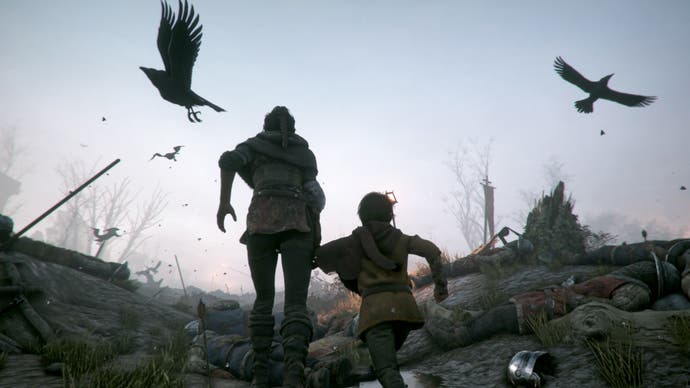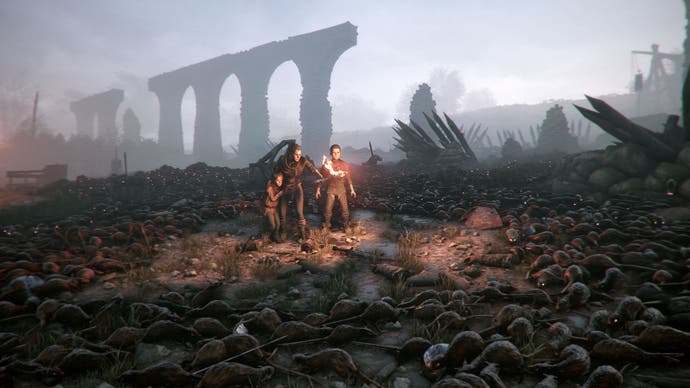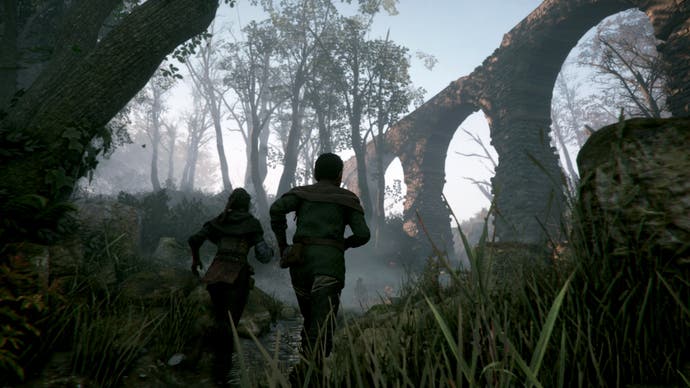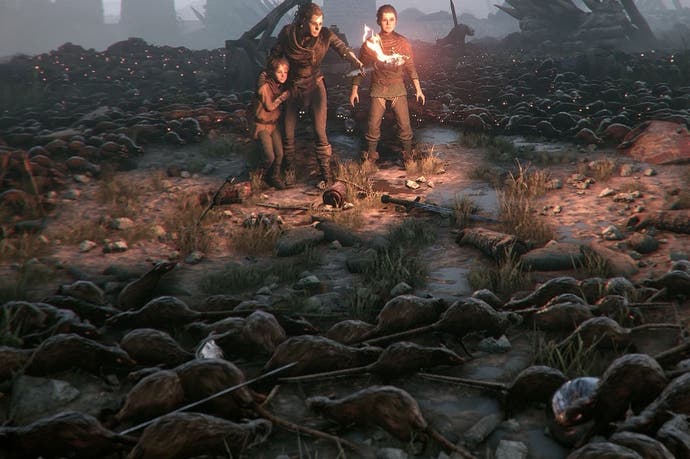A Plague Tale: Innocence wants to be The Last of Us with rats
Horde mode.
It's the eyes that really get to you - scores of them, glittering coppery-red like the pilot lights on a hundred flamethrowers. And that ceaseless ebb and surge of tiny, ravenous bodies, darting at your heels only to wince back from the glare of your torch. A Plague Tale's corner of 14th century France is home to many terrors - the black death, the Inquisition, raiding English soldiers - but the most tenacious and oppressive are the rats, a lethal mass swirling through towns hollowed out by disease and erupting from the shambles of battlefields. It's a threat you must learn to live with, while guiding nobleman's daughter Amicia and her sickly infant brother Hugo to sanctuary, and a threat you can turn to your advantage. The rats aren't fussy about who they devour, after all, and one girl's chittering Gothic metaphor is another girl's handy terrain trap.
As that gruesome notion may suggest, Innocence's narrative is all about the loss of it. Created by Asobo Studios, a developer otherwise known for contract work on projects like Quantum Break, it's a third-person "single-player co-op" odyssey in the tradition of The Last of Us, where the the rigours of travel catalyse a deepening relationship between the character you control, Amicia, and the frail soul in her charge. As the story begins, Amicia and Hugo are forced to flee their castle home by the Inquisition's appearance. Why the Church's enforcers are after them remains to be seen but presumably has to do with Hugo's mysterious terminal affliction, which is styled a "blood curse" by other characters.

The pair aren't close, to begin with. Hugo has been quarantined since birth, and Amicia isn't exactly the cuddly big sister: she harbours a certain bitterness about her brother's greater share of their mother's attention. Having been left to her own devices as a child, Amicia is also independent and resourceful where Hugo is (at first) clingy and easily spooked. It's a relationship that comes across in a variety of small ways as you play - so far, the emphasis is on such passing interactions rather than cutscenes. At one point in our demo, which occurs a third of the way through this 10-12 hour story, Hugo appears brandishing a dead man's shield, prompting Amicia to snap at him incredulously. Hugo's naivety is to some degree an asset, insulating him against a full understanding of the horrors all around. "Do you think we're hurting them?" he frets, as the pair step gingerly over corpses while attempting to reach a distant chateau.
Most of the game's puzzles seem to involve dealing with the rats, who'll overrun and consume you instantly unless kept at bay with firelight. Amicia can make torches if she has the materials, and you can set things like braziers and haystacks aflame to create pools of safety, though not everything will burn indefinitely. She also has a sling that can be used to interact with things you can't reach or, less pleasantly, knock lanterns from the hands of human foes to expose them to the rats. Some puzzles involve having Hugo wait for you or hold an object in place - keeping a trebuchet's burning arm lowered, for example, so that Amicia can tip-toe out and grab a dropped item. Where Ellie in The Last of Us could often fend for herself, however, Hugo may panic if left alone for too long, raising the alarm and getting himself killed. Direct conflict with soldiers is, needless to say, ill-advised, but Amicia can use her sling to stun attackers when there's no option but to fight.

As far as third-person games with a stealth-puzzle bent go, all of this is hardly exotic, but Amicia and Hugo seem a sympathetic duo, and the landscape they must traverse is arresting enough to make up for any apathy about how you do the traversing. Our demo took place in the shadow of an aqueduct, its upper half lost in mist as though vanishing into some other, kinder reality. Down the road there's the prospect of ghost towns, fortresses and perilous, deteriorating interiors. A Plague Tale lacks the resources and polish of a Naughty Dog project, with some rickety-looking animations - in paying tribute to the latter (the brilliant Brothers: A Tale of Two Sons is another influence), it risks inviting a ruinous comparison. But the world it portrays is captivatingly grim and grounded, alternating between a spectral hush and unholy, writhing activity.
Rats are, of course, a much-vilified species in art and media generally. They have long served as low-level opponents in games of all stripes, swarming the sewers of Dark Souls and squeaking in the cellars of MMO villages, awaiting the arrival of a level-one adventurer. It doesn't take much probing to discover that such representations owe more to human morbidity than the creature's own habits. Rats are represented as filthy; in fact, they clean and groom themselves regularly. Rats are represented as a homogeneous, selfless horde; in fact, they are sociable individuals who play together, form personal attachments and respond to one another's distress. Rats (or rather, the fleas they carry) are often branded as culprits for the explosion of bubonic plague in medieval Europe: in fact, recent research indicates that the disease was transmitted largely from human to human.

The presence of rats can actually be cause for optimism at points in the game. Those gleaming eyes may horrify, but their absence suggests that other, less tangible threats are abroad, things you can't deter with fire or bring down with a well-aimed stone. "The funny part is that the rats are innocent," lead designer Kevin Choteau hints. "When you see rats in a village that means it's safe, it means there's no sickness. If the rats start to disappear it means something bad is happening."

